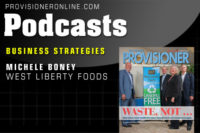What are “healthy organizations?”
Think of your own body. When you eat well, get sufficient rest and exercise regularly, your health improves. Your individual organs perform as they should, and the flow of blood, oxygen and nutrients satisfies the demands of these organs and builds their capacity. You feel better — both physically and emotionally. You are energized, your stamina increases, and your ability to cope with unusual and/or unexpected events improves. This well-being enables you to deal with tasks and relationships in a much more positive and effective manner.
We even have terms to describe this state of high performance. We say, “I’m in the zone,” or that “things are in sync,” or that doing something was so easy it was like “water off a duck’s back.” In short, you can accomplish difficult tasks with seemingly minimal effort and … feel energized afterward.
Each organization — similar to our own body — is an open system. It must contain essential components to function. Furthermore, these internal components must be aligned for the organization to be able to capitalize on opportunities in the environment, repel competitive threats and accommodate other external requirements.
Alignment is critical for the organization to be able to effectively and efficiently deliver its products, services and desired results, and to establish and sustain its preferred culture. A hallmark of a “healthy” organization is its ability to align and fully integrate these components to achieve superior performance and resource renewal. A Conference Board (2003) study identified strategic business alignment (SBA) as a competence that companies can deliberately improve and that is directly reflected in business results. SBA represents the organization’s capability to coordinate the activities of all of its components for the purpose of achieving its strategic objectives.
When does your organization need a “health check?”
An organization’s health — just as with personal health — affects not only how it performs, but ultimately if it survives. We need to practice prevention to keep the organization functioning well, and we need to heed indicators of organizational ill-health.
We need to give the organization a periodic health audit — especially when environmental factors shift (e.g. competition; legislation; market trends) — so we can take anticipatory action.
Whenever our organizations undergo major change (e.g. new technology, process redesign, merger /acquisition), we need to implement a comprehensive health audit strategy to restore balance, minimize disruption and ensure smooth transition.
When performance lags, when we dramatically lose customers or when the morale of our employees dip, we need to understand why, and take immediate action. A health audit can provide us with the diagnostic information to guide our prescriptive decision-making so we select the most appropriate corrective actions.
What should an organizational “health check” examine?
In short, the components, depth and scope of an organizational “health check” should reflect what is most needed in a given situation. In other words, it should be scalable to your specific organizational situation and history. Of paramount importance, however, is that a framework of organizational functioning be used as the foundation for this determination.
By example, when we go to our physician, he or she performs one of three types of examinations: (1) a complete physical; (2) a targeted, limited scope review; or (3) an illness- or incident-specific diagnosis. Of course, the framework being used is the human body system.
If we are conscientious about our health or, paradoxically, it has been quite some time since our last exam, a complete physical may be required. This type of examination is a comprehensive review of our total body system and typically involves numerous tests and procedures. Its objective is to provide an overall “report card” of our health condition, and to identify anything that may warrant further investigation.
Our doctor most likely will give us a targeted, limited scope examination if he/she has seen us on a regular basis; has good knowledge of our overall health-condition and wants to ensure that key “markers” of health are in line with expectations. He/she may also schedule this as part of a follow-up to a significant illness or event we’ve had or to monitor a chronic condition.
An incident- or symptom-specific examination is performed to diagnose a specific complaint we present. For instance, we may come in with back pain or knee swelling. We, as patients, may instigate this type of examination in response to changes in our normal life-situation (e.g. additional stress on the job, job loss, illness or death of a significant other).
Which organizational framework is right for you?
As indicated above, the organizational framework you select serves as the foundation for “What” you incorporate into your health-check.
So the first step is to select an organizational framework that is right for your organization. There are many different models for depicting organizational dynamics. You should consider two things in selecting a model for your company. First, does the framework make sense in terms of your understanding of organizations? And, secondly, is it easy for you to keep in mind as you examine your organization?
Based on our experience, we have identified six core elements healthy organizations use to achieve superior performance and resource renewal. These organizations:
- Align their leadership around their vision, mission and strategy (including customer/market focus);
- Establish the required process design and coordination;
- Install the right technology applications and systems;
- Create the needed organization structure, governance mechanisms and management systems;
- Fully utilize formal and informal communications;
- Establish the necessary people management strategy and support systems.
We’ve incorporated these core components (or what we refer to as “organizational drivers”) into a framework that works for us — our Business Effectiveness through Alignment & Management Framework (BEAM).
What to consider when designing your “health check”
The next step is to develop or select an assessment instrument that examines each of the core components of your model. Building an assessment tool can be fairly involved, but well worth the effort.
An alternative is to identify an existing organizational diagnostic process that fits with and can be adapted to your framework. Keep in mind, that to be optimally useful, the organizational assessment must be practical and balanced, and include actionable-recommendations grounded on best practices that yield measurable results.
We found the Malcolm Baldrige Criteria for Performance Excellence aligned with our view of organization dynamics, and also satisfied each of the other application requirements. The Baldrige criteria is recognized as the “Gold Standard” approach for assessing organizational performance excellence. It provides an assessment of the organizational processes and results. It effectively answers the questions: “How do you accomplish the work; What were the results? How well did you accomplish your work? How good are the results?” To answer these questions, we found it is important to help an organization refine and/or establish the measures and metrics needed to track quality and performance.
Poor implementation of a concept or an idea can be a quick route to failure. So the next challenge in performing an organizational “health check” is to develop a delivery method that minimizes disruption and pain to the people and operations in your company. Another implementation consideration is to have a convenient way to record information acquired through both interviews and existing data. This eases the interpretation effort of that data.
For instance, one company we worked with had conducted its own assessment. It had intentionally involved a wide spectrum of its workforce in the process. While this created a sense of involvement, it was a very tedious endeavor that lasted for several months consuming significant time and energy. In the end, the organization had so much data in such an unyielding format, that it literally created the often stated, “analysis paralysis.”
To accomplish these two implementation objectives, you may want to design a template for collecting and organizing your “health check” data. Figure 1, on page 35, presents an example template showing a partially completed section for the “Health Check” category “Customer and Market Focus.”
Leveraging “health check” data
“Health Check” data must be converted into succinct findings with actionable recommendations for you to realize the ultimate intended benefit — improved organizational performance. Additionally, your health check should include guidance on what you should do (what initiatives and projects to undertake) and the timing of when you do it.
Figure 2, on page 36, presents an abridged, sanitized version of the “Health Check” Key Findings & Recommendations we developed pertaining to the “People Capabilities and Leadership” component for a client company. Item-specific findings were generated for each of the three items within the People component: (1) Work Systems; (2) Employee Learning and Motivation, and (3) Employee Well-Being & Satisfaction. These were summarized into key findings and improvement recommendations, and were presented to the client leadership team for consideration.
Next, you may want to consider whether creating an overall summary assessment would help your management team in making business decisions — particularly with regard to capabilities needed for particular strategies, and with respect to financial allocations and people deployment. Organizations that we have assisted, frequently have found it useful to have the findings further summarized into a high-level “Health-Check” Assessment. Doing so provides an easy-to-read “report card” of the organization’s performance related to its processes and results. Some organizations utilize a “dashboard” of key metrics to monitor period-to-period performance. The Assessment Summary serves this same function from an organizational health perspective.
We structured our “Health Check” Assessment Summary on the Baldrige grading system. The Baldrige framework applies a scoring classification scale divided into six levels to grade the organization’s processes and results. Each successive Process level is described in terms of increasing maturity or robustness of four attributes, and each level contains a range of point scores. A similar grading structure exists for the organization’s Results areas.
We color-coded these levels to provide a visual assessment of the organization’s health. Our color scale ranges from Dark Green (highly efficient and effective) to Bright Red (barely observable or completely absent).
Finally, you need to determine which recommendations are worth pursuing, and which may not be in your best interest to undertake. There are numerous ways to select among alternatives. We have found a series of questions that have proven extremely helpful in guiding our clients to decide what to do and when to do it.
- Does this recommendation have a “high alignment” or only “moderate to low alignment” with your organization’s strategy?
- Will implementing this recommendation yield “substantial business results” or have only a “moderate to small impact?”
- What is the perceived “Implementation Difficulty” i.e. is it Easy vs. Tough? In determining Implementation Difficulty, you should consider such things as: resources needed, stakeholders involved, time to implement, time needed to realize benefits, extent of disruption.
Conclusion
In summary, it is important to think about your organization’s health, and to periodically administer a “health-check” strategic capabilities audit to validate your assumptions. Each of us needs to recognize that our organizations exist within an environment that holds many opportunities, but also many threats and challenges. Taking stock of our organization’s ability to effectively respond to these, often changing, conditions can be the difference between success and failure. A “health-check” will help you pinpoint things that may not be overtly visible, but, if not addressed, will weaken your organization’s resilience and diminish its overall performance. In short, a “health-check” is an important tool in your arsenal for achieving strategic business alignment. NP
Stuart M. Smith, Ph.D. is president of Targeted Performance Solutions LLC, a specialty, management consulting firm of senior level practitioners dedicated to helping organizations enhance performance, achieve bottom line growth and create and sustain their desired culture. For more information, contact him at (610) 256-2814 or stu.smith@tpsbeam.com.



Report Abusive Comment